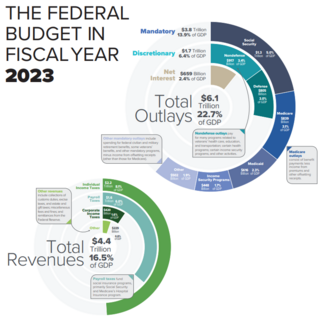Related Research Articles

The economy of Grenada is largely tourism-based, small, and open economy. Over the past two decades, the main thrust of Grenada's economy has shifted from agriculture to services, with tourism serving as the leading foreign currency earning sector. The country's principal export crops are the spices nutmeg and mace. Other crops for export include cocoa, citrus fruits, bananas, cloves, and cinnamon. Manufacturing industries in Grenada operate mostly on a small scale, including production of beverages and other foodstuffs, textiles, and the assembly of electronic components for export.
Keynesian economics are the various macroeconomic theories and models of how aggregate demand strongly influences economic output and inflation. In the Keynesian view, aggregate demand does not necessarily equal the productive capacity of the economy. It is influenced by a host of factors that sometimes behave erratically and impact production, employment, and inflation.
In economics, a recession is a business cycle contraction that occurs when there is a general decline in economic activity. Recessions generally occur when there is a widespread drop in spending. This may be triggered by various events, such as a financial crisis, an external trade shock, an adverse supply shock, the bursting of an economic bubble, or a large-scale anthropogenic or natural disaster.

Reaganomics, or Reaganism, were the neoliberal economic policies promoted by U.S. President Ronald Reagan during the 1980s. These policies are characterized as supply-side economics, trickle-down economics, or "voodoo economics" by opponents, while Reagan and his advocates preferred to call it free-market economics.

In economics and political science, fiscal policy is the use of government revenue collection and expenditure to influence a country's economy. The use of government revenue expenditures to influence macroeconomic variables developed in reaction to the Great Depression of the 1930s, when the previous laissez-faire approach to economic management became unworkable. Fiscal policy is based on the theories of the British economist John Maynard Keynes, whose Keynesian economics theorised that government changes in the levels of taxation and government spending influence aggregate demand and the level of economic activity. Fiscal and monetary policy are the key strategies used by a country's government and central bank to advance its economic objectives. The combination of these policies enables these authorities to target inflation and to increase employment. In modern economies, inflation is conventionally considered "healthy" in the range of 2%–3%. Additionally, it is designed to try to keep GDP growth at 2%–3% percent and the unemployment rate near the natural unemployment rate of 4%–5%. This implies that fiscal policy is used to stabilise the economy over the course of the business cycle.
In economics, the fiscal multiplier is the ratio of change in national income arising from a change in government spending. More generally, the exogenous spending multiplier is the ratio of change in national income arising from any autonomous change in spending. When this multiplier exceeds one, the enhanced effect on national income may be called the multiplier effect. The mechanism that can give rise to a multiplier effect is that an initial incremental amount of spending can lead to increased income and hence increased consumption spending, increasing income further and hence further increasing consumption, etc., resulting in an overall increase in national income greater than the initial incremental amount of spending. In other words, an initial change in aggregate demand may cause a change in aggregate output that is a multiple of the initial change.

Within the budgetary process, deficit spending is the amount by which spending exceeds revenue over a particular period of time, also called simply deficit, or budget deficit: the opposite of budget surplus. The term may be applied to the budget of a government, private company, or individual. Government deficit spending was first identified as a necessary economic tool by John Maynard Keynes in the wake of the Great Depression. It is a central point of controversy in economics, as discussed below.

The government budget balance, also referred to as the general government balance, public budget balance, or public fiscal balance, is the difference between government revenues and spending. For a government that uses accrual accounting the budget balance is calculated using only spending on current operations, with expenditure on new capital assets excluded. A positive balance is called a government budget surplus, and a negative balance is a government budget deficit. A government budget presents the government's proposed revenues and spending for a financial year.

In economic policy, austerity is a set of political-economic policies that aim to reduce government budget deficits through spending cuts, tax increases, or a combination of both. There are three primary types of austerity measures: higher taxes to fund spending, raising taxes while cutting spending, and lower taxes and lower government spending. Austerity measures are often used by governments that find it difficult to borrow or meet their existing obligations to pay back loans. The measures are meant to reduce the budget deficit by bringing government revenues closer to expenditures. Proponents of these measures state that this reduces the amount of borrowing required and may also demonstrate a government's fiscal discipline to creditors and credit rating agencies and make borrowing easier and cheaper as a result.

Government spending or expenditure includes all government consumption, investment, and transfer payments. In national income accounting, the acquisition by governments of goods and services for current use, to directly satisfy the individual or collective needs of the community, is classed as government final consumption expenditure. Government acquisition of goods and services intended to create future benefits, such as infrastructure investment or research spending, is classed as government investment. These two types of government spending, on final consumption and on gross capital formation, together constitute one of the major components of gross domestic product.

Fiscal policy is any changes the government makes to the national budget to influence a nation's economy. "An essential purpose of this Financial Report is to help American citizens understand the current fiscal policy and the importance and magnitude of policy reforms essential to make it sustainable. A sustainable fiscal policy is explained as the debt held by the public to Gross Domestic Product which is either stable or declining over the long term". The approach to economic policy in the United States was rather laissez-faire until the Great Depression. The government tried to stay away from economic matters as much as possible and hoped that a balanced budget would be maintained. Prior to the Great Depression, the economy did have economic downturns and some were quite severe. However, the economy tended to self-correct so the laissez faire approach to the economy tended to work.

The United States budget comprises the spending and revenues of the U.S. federal government. The budget is the financial representation of the priorities of the government, reflecting historical debates and competing economic philosophies. The government primarily spends on healthcare, retirement, and defense programs. The non-partisan Congressional Budget Office provides extensive analysis of the budget and its economic effects. CBO estimated in February 2024 that Federal debt held by the public is projected to rise from 99 percent of GDP in 2024 to 116 percent in 2034 and would continue to grow if current laws generally remained unchanged. Over that period, the growth of interest costs and mandatory spending outpaces the growth of revenues and the economy, driving up debt. Those factors persist beyond 2034, pushing federal debt higher still, to 172 percent of GDP in 2054.

Alberto Francesco Alesina was an Italian economist who was the Nathaniel Ropes Professor of Political Economy at Harvard University from 2003 until his death in 2020. He was known principally as an economist of politics and culture, and was famed for his usage of economic tools to study social and political issues. He was described as having “almost single-handedly” established the modern field of political economy, and as a likely contender for the Nobel Memorial Prize in Economic Sciences.
Political debates about the United States federal budget discusses some of the more significant U.S. budgetary debates of the 21st century. These include the causes of debt increases, the impact of tax cuts, specific events such as the United States fiscal cliff, the effectiveness of stimulus, and the impact of the Great Recession, among others. The article explains how to analyze the U.S. budget as well as the competing economic schools of thought that support the budgetary positions of the major parties.

Deficit reduction in the United States refers to taxation, spending, and economic policy debates and proposals designed to reduce the federal government budget deficit. Government agencies including the Government Accountability Office (GAO), Congressional Budget Office (CBO), the Office of Management and Budget (OMB), and the U.S. Treasury Department have reported that the federal government is facing a series of important long-run financing challenges, mainly driven by an aging population, rising healthcare costs per person, and rising interest payments on the national debt.

The United Kingdom government austerity programme is a fiscal policy that was adopted for a period in the early 21st century following the Great Recession. The term was used by the Coalition and Conservative governments in office from 2010 to 2019, and again during the 2021–present cost of living crisis. The two periods are separated by a stint of interventionist, Keynesian spending during the COVID-19 pandemic. The first period alone was “one of the biggest deficit reduction programmes seen in any advanced economy since World War II”, with the emphasis on shrinking the state rather than fiscal consolidation as was more common elsewhere in Europe.

Abenomics refers to the economic policies implemented by the Government of Japan led by the Liberal Democratic Party (LDP) since the December 2012 general election. They are named after Shinzō Abe (1954–2022), who had been appointed as Prime Minister of Japan on his second term from 2012 to 2020. Abe was the longest-serving prime minister in Japanese history. After Abe resigned in September 2020, his successor, Yoshihide Suga, stated that his premiership would focus on continuing the policies and goals of the Abe administration, including the Abenomics suite of economic policies.
As a result of the Budget Control Act of 2011, a set of automatic spending cuts to United States federal government spending in particular of outlays were initially set to begin on January 1, 2013. They were postponed by two months by the American Taxpayer Relief Act of 2012 until March 1 when this law went into effect.
Growth in a Time of Debt, also known by its authors' names as Reinhart–Rogoff, is an economics paper by American economists Carmen Reinhart and Kenneth Rogoff published in a non peer-reviewed issue of the American Economic Review in 2010. Politicians, commentators, and activists widely cited the paper in political debates over the effectiveness of austerity in fiscal policy for debt-burdened economies. The paper argues that when "gross external debt reaches 60 percent of GDP", a country's annual growth declined by two percent, and "for levels of external debt in excess of 90 percent" GDP growth was "roughly cut in half." Appearing in the aftermath of the financial crisis of 2007–2008, the evidence for the 90%-debt threshold hypothesis provided support for pro-austerity policies.

Austerity: The History of a Dangerous Idea is a 2013 book by Mark Blyth that explores the economic policy of austerity. Studying the use of austerity around the world up to the early 2010s and tracing its intellectual lineage, Blyth argues that the case for increasing economic growth through austerity is overstated, is counterproductive when implemented during recessions, and has exacerbated the Eurozone crisis. Austerity was selected among the Best Books of 2013 in reviews by the Financial Times and Bloomberg News.
References
- 1 2 Giavazzi, Fransesco; Pagano, Marco (1990). "Can Severe Fiscal Contractions Be Expansionary? Tales of Two Small European Countries" (PDF). NBER Macroeconomics Annual. 5: 75–111. doi:10.1086/654131. JSTOR 3585133. S2CID 153538736.
- ↑ Bergman, U. Michael; Hutchinson, Michael (2010). "Expansionary Fiscal Contractions: Re-evaluating the Danish Case" (PDF). International Economic Journal. 24 (1): 71–93. CiteSeerX 10.1.1.226.1733 . doi:10.1080/10168731003589857. S2CID 18227394 . Retrieved 16 December 2011.
- ↑ Barry, Frank; Devereux, Michael B. (April 1995). "The 'Expansionary Fiscal Contraction' Hypothesis: A Neo-Keynesian Analysis". Oxford Economic Papers. New Series. 47 (2): 249–264. doi:10.1093/oxfordjournals.oep.a042169. JSTOR 2663558.
- ↑ Guajardo, Jaime; Leigh, Daniel; Pescatori, Andrea (July 2011). "Expansionary Austerity: New International Evidence" (PDF). International Monetary Fund. Retrieved 22 December 2011.
- ↑ Guajardo, J.; Leigh, D. & Pescatori, A. (2014). "Expansionary austerity? International evidence". Journal of the European Economic Association. 12 (4): 949–968. doi:10.1111/jeea.12083.
- ↑ Alesina, A.; Ardagna, S. (2009). "Large changes in fiscal policy: taxes versus spending". NBER Working Paper. 15438.
- ↑ Alesina, A. & Ardagna, S. (2010). "Large changes in fiscal policy: taxes versus spending" (PDF). Tax Policy and the Economy. 24 (1): 35–68. doi:10.1086/649828.
- ↑ Maziarz, Mariusz (2019). "It's All in the Eye of Beholder" (PDF). Argumenta Oeconomica. 2 (43): 307–328. doi: 10.15611/aoe.2019.2.13 .
- ↑ Breuer, Christian (1 June 2019). "Expansionary Austerity and Reverse Causality: A Critique of the Conventional Approach". Rochester, NY. SSRN 3419588.
{{cite journal}}: Cite journal requires|journal=(help) - ↑ "Expansionary Austerity and Reverse Causality: A Critique of the Conventional Approach". Institute for New Economic Thinking. Retrieved 26 June 2020.
- ↑ "The Myth of Expansionary Austerity". Institute for New Economic Thinking. Retrieved 26 June 2020.
- ↑ Chote, Robert (March 2013). "Office for Budget Responsibility" (PDF). Office for Budget Responsibility. Retrieved 8 March 2013.